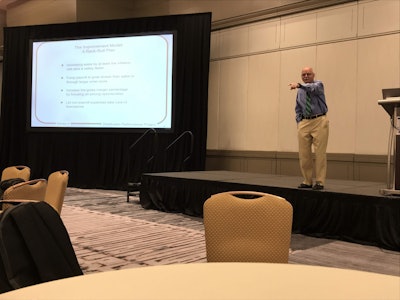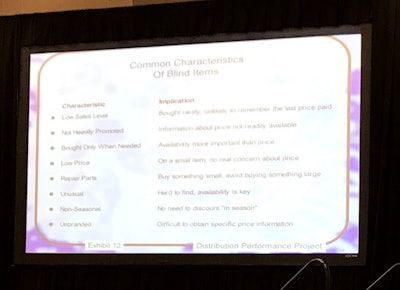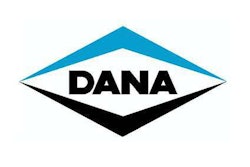 Dr. Al Bates presents Saturday at the 2019 GenNext and CVSN Distributor Training Expo in Atlanta.
Dr. Al Bates presents Saturday at the 2019 GenNext and CVSN Distributor Training Expo in Atlanta.Keeping any distribution business in the black is tough job. Dr. Al Bates makes that clear from the start.
Presenting Saturday at the fourth annual GenNext and Commercial Vehicle Solutions Network (CVSN) Distributor Training Expo in Atlanta, Bates says the skills and effort required to remain profitable in conventional distribution today are immense. Industries are evolving every day, and as more competitors and smarter customers force change, Bates says warehouse distributors are facing an increasingly uphill battle to maintain market share and profit margins.
“The thing consultants are starting to show us is if you’re making a profit [in distribution], you’re running a sensational business,” says Bates, founder and principal, Distribution Performance Project.
But while keeping a business in the black keeps the lights on and doors open, Bates says the steps necessary to transition a distribution operation from functionally profitable to truly thriving are somewhat unconventional. He says all too often distribution businesses believe the path to higher profits are more sales or fewer expenses. Bates says both of those strategies can work, but the best route to higher profits isn’t about sales volume. It’s about price.
“If we look at what drives profit in our particular industry, pricing and buying are the two most important things in our world,” he says. “Our gross margins are too low and our expenses are too high.”
Bates says a 1 percent increase in total sales increases a company’s profit by 10 percent; a 1 percent reduction in expenses is a 10.7 percent bottom-line boost. Bates admits those are good numbers. Enticing even. He says that’s the problem. Too many business leaders see those double-digit numbers and don’t dig any deeper. Both numbers are dwarfed when compared to a 1 percent change in price — where he says a 1 percent reduction in product buying price enhances profit by 21.7 percent and a 1 percent increase in retail price boosts profits by an astonishing 31.7 percent.
“I’m not going to say that making more sales is unimportant. We always need to consider that,” says Bates. “I’m only saying can we do a little bit better job in the sales context of not only focusing on new sales but also increasing the sales we have.”
 Common characteristics of blind items.
Common characteristics of blind items.He believes there’s four ways parts distributors can make that happen:
- Increase sales by inflation plus a safety factor. Bates says this one should be obvious. When raising prices due to inflation don’t shift your numbers up at the exact same percentage gain as the market. Build a buffer in there.
- Force payroll to grow slower than sales through larger order sizes. Bates is quick to point out payroll should consistently grow. His point is just that larger sales volumes will enable profit to trend up even as commissions rise.
- Increase gross margin percentages by focusing on pricing opportunities. Bates describes this as “where can we raise prices and get away with it?” The answer is blind items — i.e., products where no one has any what the price should be “and nobody cares,” he says.
- Let non-payroll expenses take care of themselves. This is more of an inaction point. Bates says don’t tinker with what isn’t broken or try to wring nickel-and-dime savings from a business that’s already running lean.
Bates also says it is important for distributors to not get caught in a race to the bottom with competition. He says all too often he sees a distributor use a sale price from a supplier as a reason to offer a retail sale price on the same item.
“That’s the kiss of death,” he says. “If we are able to buy it cheaper we need to put that in our pocket.”
And when those same supplier prices go up? Bates says follow the supplier’s lead with a percentage-based retail increase. He says too many distributors raise prices dollar-for-dollar, undercutting their own profit margin to try and maintain market share.
“I don’t care what you’re selling, if you’re afraid of competition you will underprice everything,” Bates says.










